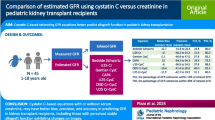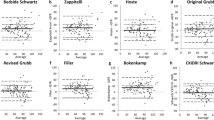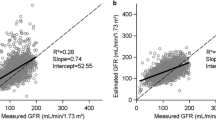Abstract
Background
Limited data exist on the performance of cystatin C-based glomerular filtration rate (GFR) equations in pediatric transplant recipients and other high-risk patients. The aim of our study was therefore to evaluate the performance of current cystatin C-based equations in this population.
Methods
This was a retrospective, cross-sectional study of 141 consecutive patients (58 % post-transplant) who received a nuclear medicine GFR (NucGFR) examination using 99mTc- diethylenetriaminepentaacetic acid at our institution. Subjects included children receiving liver, kidney or hematopoietic stem cell transplants and patients with oncologic or urologic disease. GFR estimates using published GFR estimating equations, including those based on cystatin C (Filler, Zappitelli, Larsson, Hoek, Rule and Le Bricon equations, respectively) and on both cystatin C and creatinine (Zappitelli, Bouvet and Schwartz equations, respectively), were evaluated and compared to the NucGFR measurement using Bland–Altman analysis.
Results
The mean NucGFR was 95 (interquartile range 76–111) ml/min/1.73 m2. Of the cystatin C-based equations, the Rule, Hoek, Zappitelli and Schwartz (2009 CKiD equation) formulas provided the closest agreement to the NucGFR estimate. All other formulas overestimated the GFR in our cohort.
Conclusion
Cystatin C-based GFR formulas can provide an accurate estimation of NucGFR in a pediatric population with a high proportion of transplant recipients and oncology patients.
Similar content being viewed by others
References
Dharnidharka VR, Kwon C, Stevens G (2002) Serum cystatin C is superior to serum creatinine as a marker of kidney function: a meta-analysis. Am J Kidney Dis 40:221–226
Filler G, Bokenkamp A, Hofmann W, Le Bricon T, Martinez-Bru C, Grubb A (2005) Cystatin C as a marker of GFR—history, indications, and future research. Clin Biochem 38:1–8
Bokenkamp A, Domanetzki M, Zinck R, Schumann G, Byrd D, Brodehl J (1998) Cystatin C–a new marker of glomerular filtration rate in children independent of age and height. Pediatrics 101:875–881
Filler G, Witt I, Priem F, Ehrich JH, Jung K (1997) Are cystatin C and beta 2-microglobulin better markers than serum creatinine for prediction of a normal glomerular filtration rate in pediatric subjects? Clin Chem 43:1077–1078
Bokenkamp A, Domanetzki M, Zinck R, Schumann G, Brodehl J (1998) Reference values for cystatin C serum concentrations in children. Pediatr Nephrol 12:125–129
Filler G, Lepage N (2003) Should the Schwartz formula for estimation of GFR be replaced by cystatin C formula? Pediatr Nephrol 18:981–985
Grubb A, Nyman U, Bjork J, Lindstrom V, Rippe B, Sterner G, Christensson A (2005) Simple cystatin C-based prediction equations for glomerular filtration rate compared with the modification of diet in renal disease prediction equation for adults and the Schwartz and the Counahan–Barratt prediction equations for children. Clin Chem 51:1420–1431
Zappitelli M, Parvex P, Joseph L, Paradis G, Grey V, Lau S, Bell L (2006) Derivation and validation of cystatin C-based prediction equations for GFR in children. Am J Kidney Dis 48:221–230
Filler G, Priem F, Vollmer I, Gellermann J, Jung K (1999) Diagnostic sensitivity of serum cystatin for impaired glomerular filtration rate. Pediatr Nephrol 13:501–505
Martini S, Prevot A, Mosig D, Werner D, van Melle G, Guignard JP (2003) Glomerular filtration rate: measure creatinine and height rather than cystatin C! Acta Paediatr 92:1052–1057
Schwartz GJ, Munoz A, Schneider MF, Mak RH, Kaskel F, Warady BA, Furth SL (2009) New equations to estimate GFR in children with CKD. J Am Soc Nephrol 20:629–637
Balachandran S, Toguri AG, Petrusick TW, Abbott LC (1981) Comparative evaluation of quantitative glomerular filtration rate measured by isotopic and nonisotopic methods. Clin Nucl Med 6:150–153
Brochner-Mortensen J, Haahr J, Christoffersen J (1974) A simple method for accurate assessment of the glomerular filtration rate in children. Scand J Clin Lab Invest 33:140–143
Blaufox MD, Aurell M, Bubeck B, Fommei E, Piepsz A, Russell C, Taylor A, Thomsen HS, Volterrani D (1996) Report of the Radionuclides in Nephrourology Committee on renal clearance. J Nucl Med 37:1883–1890
Barbour GL, Crumb CK, Boyd CM, Reeves RD, Rastogi SP, Patterson RM (1976) Comparison of inulin, iothalamate, and 99mTc-DTPA for measurement of glomerular filtration rate. J Nucl Med 17:317–320
Hoek FJ, Kemperman FA, Krediet RT (2003) A comparison between cystatin C, plasma creatinine and the Cockcroft and Gault formula for the estimation of glomerular filtration rate. Nephrol Dial Transplant 18:2024–2031
Larsson A, Malm J, Grubb A, Hansson LO (2004) Calculation of glomerular filtration rate expressed in mL/min from plasma cystatin C values in mg/L. Scand J Clin Lab Invest 64:25–30
Le Bricon T, Thervet E, Froissart M, Benlakehal M, Bousquet B, Legendre C, Erlich D (2000) Plasma cystatin C is superior to 24-h creatinine clearance and plasma creatinine for estimation of glomerular filtration rate 3 months after kidney transplantation. Clin Chem 46:1206–1207
Rule AD, Bergstralh EJ, Slezak JM, Bergert J, Larson TS (2006) Glomerular filtration rate estimated by cystatin C among different clinical presentations. Kidney Int 69:399–405
Bouvet Y, Bouissou F, Coulais Y, Seronie-Vivien S, Tafani M, Decramer S, Chatelut E (2006) GFR is better estimated by considering both serum cystatin C and creatinine levels. Pediatr Nephrol 21:1299–1306
Bland JM, Altman DG (1986) Statistical methods for assessing agreement between two methods of clinical measurement. Lancet 1:307–310
Perrone RD, Madias NE, Levey AS (1992) Serum creatinine as an index of renal function: new insights into old concepts. Clin Chem 38:1933–1953
Samyn M, Cheeseman P, Bevis L, Taylor R, Samaroo B, Buxton-Thomas M, Heaton N, Rela M, Mieli-Vergani G, Dhawan A (2005) Cystatin C, an easy and reliable marker for assessment of renal dysfunction in children with liver disease and after liver transplantation. Liver Transpl 11:344–349
Berding G, Geisler S, Melter M, Marquardt P, Luhr A, Scheller F, Knoop BO, Pfister ED, Pape L, Bischoff L, Knapp WH, Ehrich JH (2010) Estimation of glomerular filtration rate in liver-transplanted children: comparison of simplified procedures using 51Cr-EDTA and endogenous markers with Sapirstein’s method as a reference standard. Pediatr Transplant 14:786–795
Blufpand HN, Tromp J, Abbink FC, Stoffel-Wagner B, Bouman AA, Schouten-van Meeteren AY, van Wijk JA, Kaspers GJ, Bokenkamp A (2011) Cystatin C more accurately detects mildly impaired renal function than creatinine in children receiving treatment for malignancy. Pediatr Blood Cancer 57:262–267
Bacchetta J, Cochat P, Rognant N, Ranchin B, Hadj-Aissa A, Dubourg L (2011) Which creatinine and cystatin C equations can be reliably used in children? Clin J Am Soc Nephrol 6:552–560
Mention K, Lahoche-Manucci A, Bonnevalle M, Pruvot FR, Declerck N, Foulard M, Gottrand F (2005) Renal function outcome in pediatric liver transplant recipients. Pediatr Transplant 9:201–207
Borrows R, Cockwell P (2007) Measuring renal function in solid organ transplant recipients. Transplantation 83:529–531
Takeuchi M, Fukuda Y, Nakano I, Katano Y, Hayakawa T (2001) Elevation of serum cystatin C concentrations in patients with chronic liver disease. Eur J Gastroenterol Hepatol 13:951–955
Demirtas S, Akan O, Can M, Elmali E, Akan H (2006) Cystatin C can be affected by nonrenal factors: a preliminary study on leukemia. Clin Biochem 39:115–118
Chu SC, Wang CP, Chang YH, Hsieh YS, Yang SF, Su JM, Yang CC, Chiou HL (2004) Increased cystatin C serum concentrations in patients with hepatic diseases of various severities. Clin Chim Acta 341:133–138
Boudville N, Salama M, Jeffrey GP, Ferrari P (2009) The inaccuracy of cystatin C and creatinine-based equations in predicting GFR in orthotopic liver transplant recipients. Nephrol Dial Transplant 24:2926–2930
Chew JS, Saleem M, Florkowski CM, George PM (2009) Estimating renal function in oncology patients using cystatin C-based equations. Clin Oncol (R Coll Radiol) 21:425–426
Gerhardt T, Poge U, Stoffel-Wagner B, Ahrendt M, Wolff M, Spengler U, Palmedo H, Sauerbruch T, Woitas RP (2006) Estimation of glomerular filtration rates after orthotopic liver transplantation: evaluation of cystatin C-based equations. Liver Transpl 12:1667–1672
Stake G, Monn E, Rootwelt K, Monclair T (1991) The clearance of iohexol as a measure of the glomerular filtration rate in children with chronic renal failure. Scand J Clin Lab Invest 51:729–734
Houlihan C, Jenkins M, Osicka T, Scott A, Parkin D, Jerums G (1999) A comparison of the plasma disappearance of iohexol and 99mTc-DTPA for the measurement of glomerular filtration rate (GFR) in diabetes. Aust N Z J Med 29:693–700
Schwartz GJ, Furth S, Cole SR, Warady B, Munoz A (2006) Glomerular filtration rate via plasma iohexol disappearance: pilot study for chronic kidney disease in children. Kidney Int 69:2070–2077
Ling Q, Xu X, Li J, Wu J, Chen J, Xie H, Zheng S (2008) A new serum cystatin C-based equation for assessing glomerular filtration rate in liver transplantation. Clin Chem Lab Med 46:405–410
Risch L, Herklotz R, Blumberg A, Huber AR (2001) Effects of glucocorticoid immunosuppression on serum cystatin C concentrations in renal transplant patients. Clin Chem 47:2055–2059
Qutb A, Syed G, Tamim HM, Al Jondeby M, Jaradat M, Tamimi W, Al Ghamdi G, Al Qurashi S, Flaiw A, Hejaili F, Al Sayyari AA (2009) Cystatin C-based formula is superior to MDRD, Cockcroft–Gault and Nankivell formulae in estimating the glomerular filtration rate in renal allografts. Exp Clin Transpl 7:197–202
White C, Akbari A, Hussain N, Dinh L, Filler G, Lepage N, Knoll GA (2007) Chronic kidney disease stage in renal transplantation classification using cystatin C and creatinine-based equations. Nephrol Dial Transplant 22:3013–3020
White C, Akbari A, Hussain N, Dinh L, Filler G, Lepage N, Knoll GA (2005) Estimating glomerular filtration rate in kidney transplantation: a comparison between serum creatinine and cystatin C-based methods. J Am Soc Nephrol 16:3763–3770
Maillard N, Mariat C, Bonneau C, Mehdi M, Thibaudin L, Laporte S, Alamartine E, Chamson A, Berthoux F (2008) Cystatin C-based equations in renal transplantation: moving toward a better glomerular filtration rate prediction? Transplantation 85:1855–1858
Zahran A, Qureshi M, Shoker A (2007) Comparison between creatinine and cystatin C-based GFR equations in renal transplantation. Nephrol Dial Transplant 22:2659–2668
Poge U, Gerhardt T, Stoffel-Wagner B, Palmedo H, Klehr HU, Sauerbruch T, Woitas RP (2006) Cystatin C-based calculation of glomerular filtration rate in kidney transplant recipients. Kidney Int 70:204–210
Poge U, Gerhardt T, Woitas RP (2008) Equations to estimate GFR using serum cystatin C in kidney transplant recipients. Am J Kidney Dis 52:383–384
Huang SH, Macnab JJ, Sontrop JM, Filler G, Gallo K, Lindsay RM, Clark WF (2011) Performance of the creatinine-based and the cystatin C-based glomerular filtration rate (GFR) estimating equations in a heterogenous sample of patients referred for nuclear GFR testing. Transl Res 157:357–367
Conflict of Interest statement
There are no conflicts of interest to disclose.
Financial statement
No financial support was received.
Author information
Authors and Affiliations
Corresponding author
Rights and permissions
About this article
Cite this article
Nehus, E.J., Laskin, B.L., Kathman, T.I. et al. Performance of cystatin C-based equations in a pediatric cohort at high risk of kidney injury. Pediatr Nephrol 28, 453–461 (2013). https://doi.org/10.1007/s00467-012-2341-3
Received:
Revised:
Accepted:
Published:
Issue Date:
DOI: https://doi.org/10.1007/s00467-012-2341-3




